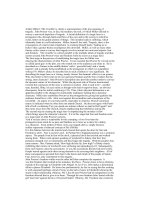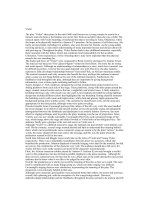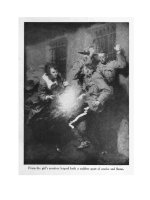Hey, buddy, wanna buy a piece of the empire state building pdf
Bạn đang xem bản rút gọn của tài liệu. Xem và tải ngay bản đầy đủ của tài liệu tại đây (27.09 KB, 3 trang )
Hey, buddy, wanna buy a piece of the empire state building?
Clarification attached
DOUG JOHNSON: Welcome to AMERICAN MOSAIC in VOA Special English.
I’m Doug Johnson. On our show today we play music from rock band Nickelback …
We also answer a question from China about the state of Alaska …
But first, another question could a historic piece of New York City be up for sale soon?
Empire State Building
DOUG JOHNSON: Americans like to joke about the Brooklyn Bridge in New York City.
They use the expression “selling the Brooklyn Bridge” to describe a person who wants to
trick someone else. Individuals have, in fact, offered to sell the publicly owned structure
to trusting buyers. But it is not for sale.
But, over the years, we have never heard about someone selling New York’s Empire
State Building until now. Christopher Cruise explains.
CHRISTOPHER CRUISE: The Empire State Building was the tallest structure in the
world for more than forty years. Work on the building was finished in nineteen thirty-
one. While it is no longer the tallest, it is probably the most famous. People from around
the world visit its eighty-sixth floor observatory to see New York from high above.
Ten years ago, the Malkin family bought the Empire State Building for more than fifty-
seven million dollars. Now, the family is considering selling shares in a publicly traded
company that would operate buildings in New York and the state of Connecticut.
Teresa Martin set up the Real Estate Investment Association in New York. She wonders
why the Malkin family is considering selling shares in the buildings.
TERESA MARTIN: “It may be that they may be in trouble and need to raise some funds.
But it may just mean that they want to expand and need investor dollars to actually, you
know, do what they foresee in their vision to do.”
Some people with offices in the Empire State Building say they are not happy with its
restrooms and elevator equipment. The Malkin family has spent at least five hundred fifty
million dollars making changes to the building, including replacing more than six
thousand five hundred windows.
The cost of office space has more than doubled. The New York Times newspaper says
the number of occupants has been dropped from nine hundred fifty in two thousand two
to about two hundred now. But those leasing space in the building now have much larger
offices.
Teresa Martin plans to buy shares in the Empire State Building. But she does not plan to
put all of her money into the investment.
TERESA MARTIN: “If you’re telling me that I can get it for ten dollars a share, let’s say,
would I get a hundred shares? Yeah. Would I get like two hundred thousand? Probably
not. But I would get a piece.”
The one-hundred-two-story building is often lit up at night in honor of different causes or
events. The New York Times spoke with someone who knows about the plan to sell
shares in the real estate company. The person said the building would be lit up in green
lights – the color of American money – if the plan to sell shares comes to pass. More
details are expected early next year.
Watch a video version of this story:
Alaska
DOUG JOHNSON: Our listener question this week comes from Henan Province in
China. Chenvican wants to know the history of America’s largest state Alaska.
The United States bought Alaska from Russia in eighteen sixty-seven for seven million
dollars. That is less than five cents a hectare.
At the time, many Americans criticized the purchase. But it was one of the best deals the
country ever made. Alaska proved rich in oil and minerals.
<! IMAGE-LEFT >
Gold was found nearby in the Yukon area of Canada in the eighteen nineties. Thousands
of people traveled to the Yukon through Alaska hoping to get rich. Most never did. But
some of them decided to stay in Alaska. Mainly they earned their money as miners,
fishermen, animal trappers and store owners.
Alaska became an official territory of the United States in nineteen twelve. Four years
later, the first Alaskan statehood bill was proposed in Congress. Opponents argued that
Alaska was far away, disconnected from the other states and little populated. Only about
fifty-eight thousand people lived there at the time.
Yet those were not the only concerns. Historians say Congress was also unsure about the
loyalties of native Alaskans the Aleuts, Indians and Eskimos. But during World War
Two, national leaders recognized the importance of the territory to security in the Pacific.
The United States entered the war in nineteen forty-one after Japanese planes attacked the
Navy base at Pearl Harbor, Hawaii. The surprise attack sank many ships. After that,
Congress provided billions of dollars in defense spending for Alaska. Today, federal
spending is one of the most important parts of the state economy.
After the war, Alaskans were more serious than ever about statehood. They formed a
Statehood Committee in nineteen forty-nine to work toward that goal.
Finally, in nineteen fifty-eight, Congress passed the Alaska Statehood Bill and President
Dwight Eisenhower signed it into law. Alaskans accepted it, and on January third,
nineteen fifty-nine, President Eisenhower declared Alaska the forty-ninth state.
(MUSIC)
Nickelback
DOUG JOHNSON: The Canadian band Nickelback is a band critics love to hate. But the
four-man, hard rock group is still a big success. Their new album, “Here and Now,” came
out late last month. Barbara Klein has some of the songs.
BARBARA KLEIN: Nickelback formed in nineteen ninety-five. “Here and Now” is the
band’s seventh album. It entered Billboard magazine’s Top Two Hundred Albums chart
in the number two position. It is number one on Billboard’s Rock, Hard Rock and
Alternative charts.
<! IMAGE-LEFT >
Nickelback songs are mainly about two subjects: sex and drinking. This album, however,
also includes the song, “When We Stand Together.” It tells about war and society’s
reaction to it:
There's bullets flying through the air
And they still carry on
We watch it happen over there
And then just turn it off
And then the song calls for change. It says that everybody wins when people stand
together, hand in hand.
(MUSIC)
“When We Stand Together” is one of the first two singles released by “Nickelback.” The
other is a drinking song, “Bottoms Up.”
(MUSIC)
Some people might find the songs offensive. But the band does offer a love song or two.
“Trying Not to Love You,” tells the sad story of someone whose love is not returned.
You hear the following words again and again:
Trying not to love you only goes so far,
Trying not to need you is tearing me apart
And finally the singer expresses this sad conclusion:
Cause trying not to love you,
Only makes me love you more
(MUSIC)
Nickelback seems to take criticism well. Recently, tens of thousands of people in
Michigan signed a proposal to keep the band from performing at a Detroit Lions football
game. Nickelback members answered by making fun of themselves in a video for a
humorous web series, “Funny or Die.” That is the kind of cool that comes with selling
more than fifty million albums.
We leave you with Nickelback performing “Lullaby” from their new album, “Here and
Now.”
(MUSIC)
DOUG JOHNSON: I’m Doug Johnson. Our program was written by Christopher Cruise
and Caty Weaver, who was also our producer. And Mario Ritter was our reader.
Join us again next week for music and more on AMERICAN MOSAIC in VOA Special
English.
Clarification: Some references in this story might have suggested that the Empire
State Building might be put on the market for sale. As the story correctly explains, the
building might be turned into a publicly traded real estate company in which shares
would be sold.









